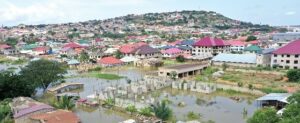Geological Survey cautions against building along earthquake zones Weija, MacCarthy, Aburi ridges

Mr Isaac Kuuwan Mwinbelle, the Acting Director General of the Ghana Geological Survey Authority (GGSA), has cautioned private and commercial developers against building along the MacCarthy Hill, Weija and Aburi ridges.
He described those areas as “high risk zones” and that occupants would experience the impact of any future earthquake or tremor, the most.
“You are putting yourselves in danger. City authorities must stop such activities,” he said.
Mr Mwinbelle told the Ghana News Agency in Accra that those areas were not meant for human habitation and that even if one wanted to site a building there, it must be earthquake resistant.
He said other areas were: Gbawe, Kwabenya, Ofankor, Nkawkaw scarp, Voltaian Scarp, Jamase-Ashanti Mampong, Gambaga-Nakpanduri Road and Larteh.
Mr Mwinbelle advised developers not to waste resources and put the lives of people in danger, urging them to learn from last week’s earthquakes in Turkiye and Syria.
He said indications were that, Ghana could experience earthquake anytime and that the best approach to reduce the impact was to avoid high risk zones and adhere to safety standards.
The Acting Director General explained that once the country had experienced earthquakes in the past, with some related activities recorded in January 2023, it was important that it prepared adequately to reduce any impacts.
He said the Authority had Seismic stations dotted across the country that monitored the earth’s movement and detected possible earthquake events.
“However, this is seen at a short time frame prior to the event so it does not afford us the opportunity to provide early warning signals for preparations to be made towards it,” he said.
To ensure safety in the construction sector, he advised the public to consult the GGSA to undertake geological assessment at sites and provide technical advice before putting up buildings.
“There are a number of areas that have faults – fracture or zone of fractures between two blocks of rock and its movement can be slow or rapid in the form of earthquake. They are dangerous areas and not habitable but people are putting up structures in these areas,” he noted.
An earthquake is the shaking of the surface of the earth due to the sudden release of energy in the earth’s crust. They are caused by sudden tectonic movements in the earth’s crust. When the tectonic plates slide over one another, there is a cause of orogeny, which results in earthquakes.
These disturbances cause vibrations that spread in all directions.
Ghana experienced its first earthquake at a magnitude of 6.5 in 1862, resulting in the death of thre people.
In 1906, the country experienced an earth tremor, which hit parts of the Volta Region, with no record of damage.
It was followed by the 1939 event at a magnitude of 6.6, killing 17 persons, leaving 133 others with different degrees of injury.
There was one in January 1997 at a magnitude of 3.8, another 4.1 magnitude in February, and 4.8 magnitude in March, the same year.
In 2003, 2006, 2007, the country recorded earthquakes of magnitude 3.8, magnitude 3.7, and 5.2, respectively.
From 2018 to 2023, Ghana has witnessed a series of earth tremors on a yearly basis.
Source: GNA
